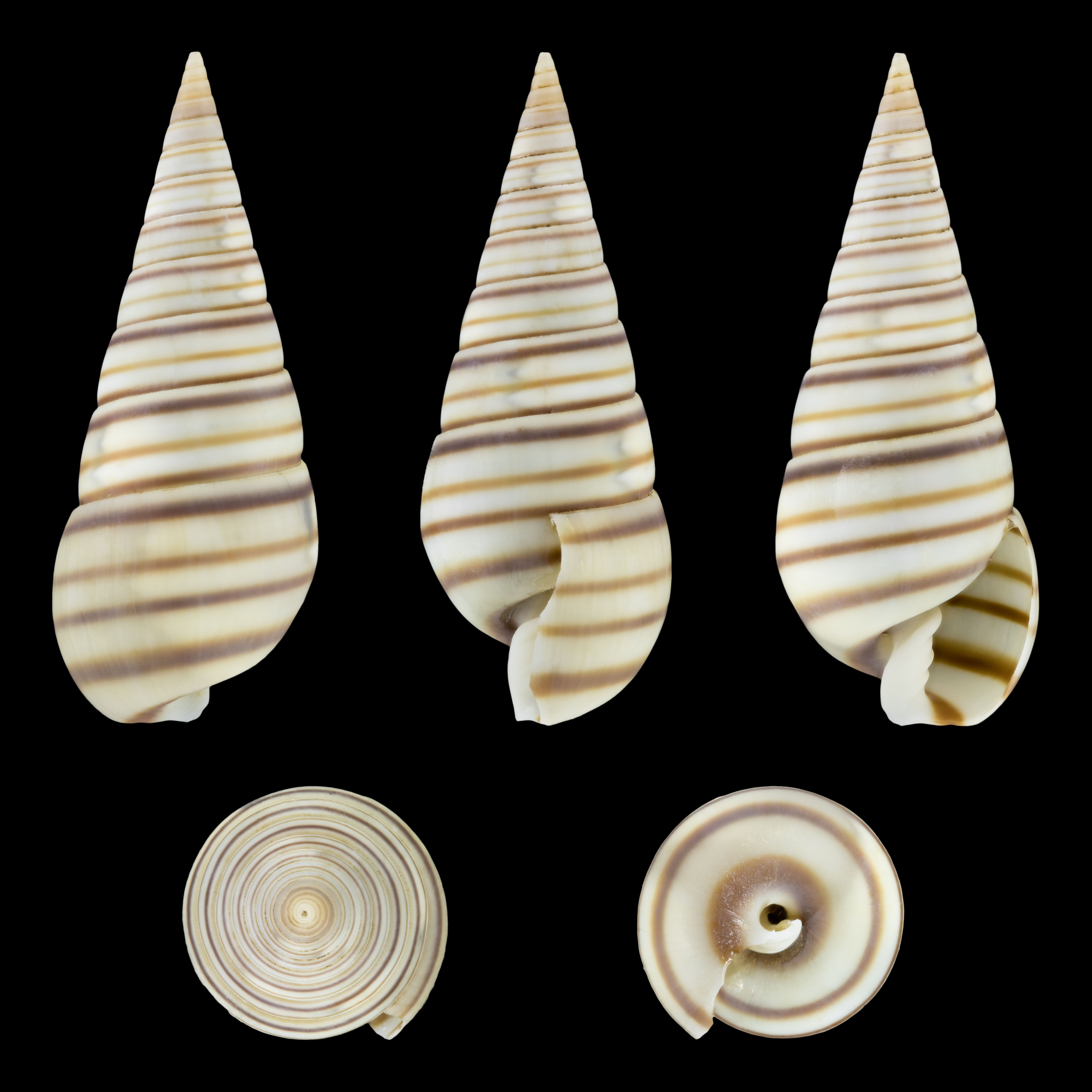|
Pyramidella Dolabrata
''Pyramidella dolabrata'', common name the "giant Atlantic pyram", is a somewhat variable species of small to medium-sized (max size 36 mm) sea snail, a marine gastropod mollusk in the (mostly minute) family Pyramidellidae, the pyram snails. Description The length of the shell varies between 14 mm and 36 mm. The white shell is conical, turreted, polished, elongated, slightly transparent. It has three or four transverse, narrow reddish or chestnut spiral lines on the body whorl, and two on the whorls of the teleoconch. The middle band s always narrowest ; the others are wider and deeper colored. The pointed spire is composed of from ten to twelve distinct, smooth, slightly convex whorls. The body whorl is more inflated than the other whorls. The shell is smooth and umbilicated. The ovate aperture is subrotund at its base, and generally marked within, with very prominent ridges continued upon some specimens even to the edge of the sharp outer lip. The outer lip i ... [...More Info...] [...Related Items...] OR: [Wikipedia] [Google] [Baidu] |
Gastropod Shell
The gastropod shell is part of the body of a Gastropoda, gastropod or snail, a kind of mollusc. The shell is an exoskeleton, which protects from predators, mechanical damage, and dehydration, but also serves for muscle attachment and calcium storage. Some gastropods appear shell-less (slugs) but may have a remnant within the mantle, or in some cases the shell is reduced such that the body cannot be retracted within it (semi-slug). Some snails also possess an operculum that seals the opening of the shell, known as the Aperture (mollusc), aperture, which provides further protection. The study of mollusc shells is known as conchology. The biological study of gastropods, and other molluscs in general, is malacology. Shell morphology terms vary by species group. Shell layers The gastropod shell has three major layers secreted by the Mantle (mollusc), mantle. The calcareous central layer, tracum, is typically made of calcium carbonate precipitated into an organic matrix known as c ... [...More Info...] [...Related Items...] OR: [Wikipedia] [Google] [Baidu] |
Lip (gastropod)
In the shell of gastropod mollusks (a snail shell), the lip is the free margin of the peristome (synonym: peritreme) or aperture (the opening) of the gastropod shell. In dextral (right-handed) shells (most snail shells are right-handed), the right side or outer side of the aperture is known as the outer lip (''labrum''). The left side of the aperture is known as the inner lip or columellar lip (''labium'') if there is a pronounced lip there. In those species where there is no pronounced lip, the part of the body whorl that adjoins the aperture is known as the parietal wall. The outer lip is usually thin and sharp in immature shells, and in some adults (e.g. the land snails ''Helicella'' and '' Bulimulus''). However, in some other land snails and in many marine species the outer lip is ''thickened'' (also called ''callused''), or ''reflected'' (turned outwards). In some other marine species it is curled inwards (''inflected''), as in the cowries such as ''Cypraea''. It can also be ... [...More Info...] [...Related Items...] OR: [Wikipedia] [Google] [Baidu] |
Gastropods Of Cape Verde
The gastropods (), commonly known as snails and slugs, belong to a large taxonomic class of invertebrates within the phylum Mollusca called Gastropoda (). This class comprises snails and slugs from saltwater, from freshwater, and from land. There are many thousands of species of sea snails and slugs, as well as freshwater snails, freshwater limpets, and land snails and slugs. The class Gastropoda contains a vast total of named species, second only to the insects in overall number. The fossil history of this class goes back to the Late Cambrian. , 721 families of gastropods are known, of which 245 are extinct and appear only in the fossil record, while 476 are currently extant with or without a fossil record. Gastropoda (previously known as univalves and sometimes spelled "Gasteropoda") are a major part of the phylum Mollusca, and are the most highly diversified class in the phylum, with 65,000 to 80,000 living snail and slug species. The anatomy, behavior, feeding, and reproduct ... [...More Info...] [...Related Items...] OR: [Wikipedia] [Google] [Baidu] |
Molluscs Of Mauritius
Mollusca is the second-largest phylum of invertebrate animals after the Arthropoda, the members of which are known as molluscs or mollusks (). Around 85,000 extant species of molluscs are recognized. The number of fossil species is estimated between 60,000 and 100,000 additional species. The proportion of undescribed species is very high. Many taxa remain poorly studied. Molluscs are the largest marine phylum, comprising about 23% of all the named marine organisms. Numerous molluscs also live in freshwater and terrestrial habitats. They are highly diverse, not just in size and anatomical structure, but also in behaviour and habitat. The phylum is typically divided into 7 or 8 taxonomic classes, of which two are entirely extinct. Cephalopod molluscs, such as squid, cuttlefish, and octopuses, are among the most neurologically advanced of all invertebrates—and either the giant squid or the colossal squid is the largest known invertebrate species. The gastropods (s ... [...More Info...] [...Related Items...] OR: [Wikipedia] [Google] [Baidu] |




